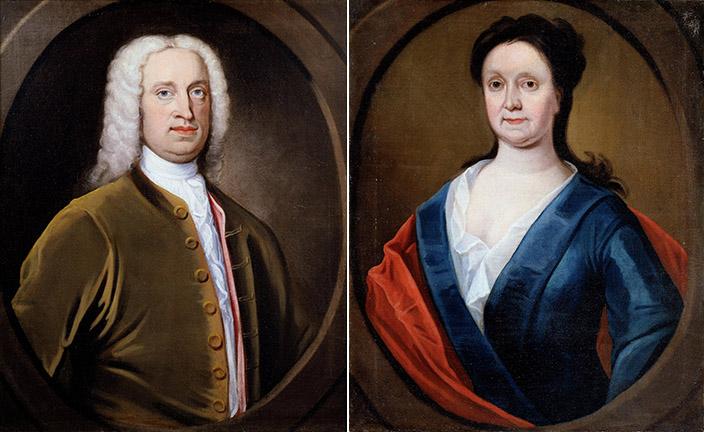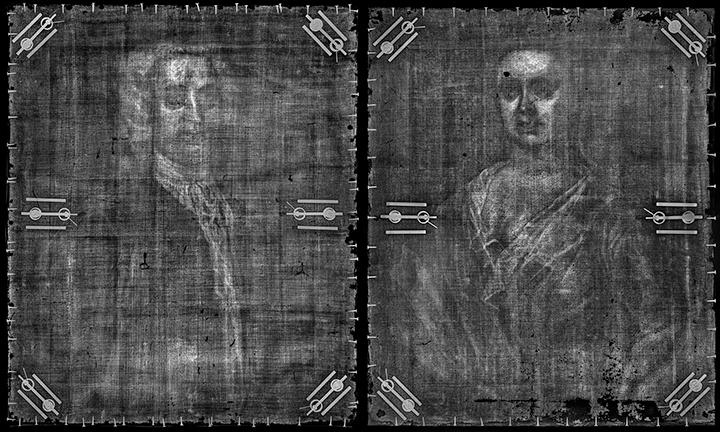NEW YORK CITY — Raising questions of authenticity and fraud, “Masterpieces & Curiosities: The Fictional Portrait” will reveal surprising new analysis of two portraits once thought to depict an Eighteenth Century Jewish couple. On view at the Jewish Museum March 18–August 14, the exhibition will present the disputed works alongside a selection of other portraits from the museum’s collection, offering a reflection on questions of truth and representation in portraiture.

Unknown artist/maker, portraits of a man and woman, circa 1750, oil on canvas. The Jewish Museum, New York, gift of Dr Harry G. Friedman.
During a decade of research, the identities of the artist and sitters have been reconsidered through archival investigation, genealogical studies, and recent X-ray analysis. “Masterpieces & Curiosities” continues a series of exhibitions focused on individual works in the museum’s renowned collection.
At the time of their acquisition in 1957, the two key works in this exhibition were believed to be portraits of Judah Mears and his wife Jochabed Michaels, made around 1740 and attributed to Jeremiah Theus, an American colonial portraitist active in Charleston, S.C. Scholarly examination of the paintings indicates that they do not resemble other works by Theus, and no other visual representations of the couple are known to exist. In 2015, the Jewish Museum commissioned stereomicroscopic examination and technical imaging of the two portraits. This analysis revealed that the works, though most likely produced in the Eighteenth Century, were painted with different pigments using different methods. X-ray and infrared scans of the paintings will be reproduced in the exhibition.
Only one source is known to document the paintings. A 1957 note from the seller, Marie Ambrose, to the Jewish Museum traces the history and ownership of the paintings. The stated provenance was researched and deemed plausible at the time. However, there is evidence of widespread fraud in the market for early American portraits during the first part of the Twentieth Century. Frank Bayley, a noted Boston art dealer, is mentioned in the seller’s note, raising further questions. Bayley was implicated in the fraudulent sale of portraits, including one of George Washington in 1928, which led to closure of his gallery and ultimately to Bayley’s death in 1932.
Given the lack of hard evidence for the provenance of the paintings, a theory emerges: the works were not painted by Jeremiah Theus, do not depict Judah and Jochabed Mears, and were likely given a false attribution when transferred from Bayley’s gallery to Marie Ambrose, possibly in the late 1920s or early 1930s. The works may have originated in England or Scotland and appear to have undergone some alteration before being brought together as a couple.
Traditionally, portraits speak both to the time when they were created and to the future. Serving as repositories of memory and generating a sense of familial continuity, such portraits are often entwined with considerations of genealogy and status. Portraits commissioned by Jewish patrons or families in the young United States, in addition to fulfilling the traditional functions of remembrance and recognition, also served as visual statements of social standing and belonging. Common-sense interpretations of portraits often involve intuiting some direct relation between the image and the sitter. However, there is risk in reading character or history into a representation that is mediated by the artist, the sitter, and the viewer, whether in the past or today.
In addition to the disputed works and related materials, The exhibition will include other portraits from the collection of the Jewish Museum produced between 1680 and 1900. Some notable examples from the wide variety of portraits in the museum’s collection are featured, including works by unknown artists or of unknown sitters. On view will be portraits by prominent artists such as Thomas Sully, “the prince of American portrait painters.” There are depictions of other significant figures: Solomon Isaacs, president of New York’s Jewish community in 1790; a portrait by a student of Rembrandt considered by some to be of philosopher Baruch Spinoza; and silhouettes of such notables as philanthropist Judah Touro, created during the 1840s, when the medium was at the height of its popularity.
Over the course of seven exhibitions in the “Masterpieces & Curiosities” series, which runs from 2013 to 2017, the museum’s curators are exploring objects that highlight the breadth and diversity of the collection, ranging from an iconic Diane Arbus photograph to a Hanukkah lamp designed by Peter Shire. These intimate exhibitions provide new insights into works from the collection:- contextualizing, examining, and rethinking the piece on view by surrounding it with other artworks, documents, and source materials.
Stephen Brown, associate curator, curated “The Fictional Portrait.” The Masterpieces & Curiosities series was organized by Jens Hoffmann, Deputy Director, Exhibitions and Public Programs, and coordinated by Daniel S. Palmer, Leon Levy Assistant Curator.
The Jewish Museum is at 1109 Fifth Avenue at 92nd Street. For more information, www.thejewishmuseum.org or 212-423-3200.


